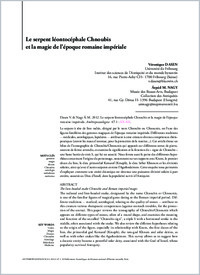Le serpent léontocéphale Chnoubis et la magie de l’époque romaine impériale
- Dasen, Véronique Université de Fribourg
- Nagy, Árpád M. Musée des Beaux-Arts, Budapest
-
2012
Published in:
- Anthropozoologica. - 2012, vol. 47, no. 1, p. 291-314
gemmes
magie
décans
Chnoubis
astrologie
mélothésie
médecine
Gems
Magic
Decans
Chnoubis
Astrology
Melothesia
Medicine
English
French
The lion-headed snake Chnoubis and Roman imperial magic The radiated and lion- headed snake, designated by the name Chnoubis or Chnoumis, is one of the familiar figures of magical gems dating to the Roman imperial period. Different traditions - medical, astrological, relating to the quality of stones - attribute to this creature various therapeutic competences (against stomach troubles, for the protection of the uterus). This paper reviews the iconography of Chnoubis/Chnoumis which appears on different types of stones, often of a round shape, and examines the meaning and function of the so-called “Chnoubis sign”, a triple S with a horizontal stroke in the middle, often associated wirth the snake. We also review the different hypotheses relating to the origin of the figure, especially its relationship with Knem, the first decan of the lion, the primordial god Kematef (Kmeph), the ram-god Khnum and solar deities, as well as with other snakes like the Agathodaimon. This survey allows us to suggest how a decanic entity became a powerful solar deity, associated with the God of Israel, whose popularity survived Antiquity.
Le serpent à tête de lion radiée, désigné par le nom Chnoubis ou Chnoumis, est l'une des figures familières des gemmes magiques de l'époque romaine impériale. Différentes traditions - médicales, astrologiques, lapidaires - attribuent à cette créature diverses compétences thérapeutiques (contre les maux d'estomac, pour la protection de la matrice...). Cet article dresse un bilan de l'iconographie de Chnoubis/Chnoumis qui apparaît sur différentes sortes de pierre, souvent de forme arrondie, et examine la signification et la fonction du « signe de Chnoubis » une haste barrée de trois S, qui lui est associé. Nous ferons aussi le point des différentes hypothèses concernant l'origine du personnage, notamment sur ses rapports avec Knem, le premier décan du lion, le dieu primordial Kematef (Kmeph), le dieu bélier Khnoum et les divinités solaires, ainsi qu'avec d'autres serpents comme l'Agathodaimon. Cette enquête nous permettra d'expliquer comment une entité décanique est devenue une puissante divinité solaire à part entière, associée au Dieu d'Israël, dont la popularité survit à l'Antiquité.
- Faculty
- Faculté des lettres et des sciences humaines
- Department
- Département d'histoire de l'art et d'archéologie
- Language
-
- French
- Classification
- Anthropology, ethnography
- License
-
License undefined
- Identifiers
-
- RERO DOC 232866
- DOI 10.5252/az2012n1a8
- Persistent URL
- https://folia.unifr.ch/unifr/documents/303898
Statistics
Document views: 137
File downloads:
- Anthropozoologica_2012: 338
